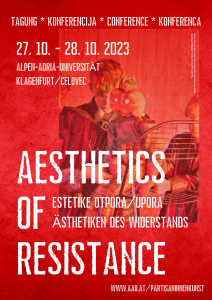Forschung
Zu den Schwerpunkten in der literaturwissenschaftlichen Forschung zählen Kinder- und Jugendliteratur, literarische Übersetzung, die Postmoderne, die Beziehung zwischen Literatur und Identität, Gender, Erzählforschung sowie Literatur und Krieg. Im Bereich der Sprachwissenschaft liegt der Fokus einerseits auf der audiovisuellen und slowenischen Dialektologie, der Mehrsprachigkeitsforschung, auf der Erforschung des Sprachwandels sowie kontrastiver Textologie und Genderlinguistik, andererseits auf der grammatiktheoretischen, lexikologischen und semantischen Forschung. Die kulturwissenschaftliche Forschung befasst sich mit kultur- und geistesgeschichtlichen Themenstellungen, dem Zusammenhang von Sprache und Kultur, arealwissenschaftlichen Fragestellungen sowie mit Alltags- und Hochkultur.
Tagungen
Internationale Tagung:
Ästhetiken des Widerstands. Partisan:innenkunst und feministische partisanische Kulturpraxis in Jugoslawien und Kärnten/Koroška
Konferenca:
Estetike upora. Partizanska umetnost in feministična partizanska kulturna praksa v Jugoslaviji in na Koroškem
Konferencija:
Estetike otpora. Partizanska umjetnost i feministička praksa partizanske kulture u Jugoslaviji i Koruškoj

Our goal is to organize a conference that addresses and questions current artistic and scientific positions on partisan art through the lens of gender and gender-theories. The focus lies on art and culture both of the partisan movement and about the partisan movement in Yugoslavia and Carinthia.
The question that guides this conference is: how – in addition to politically and socially rooted themes such as the struggle for liberation, the question of class, the socialist revolution, and the victory over Nazism – can we pinpoint aesthetics of the “partisan” that conveys specific revolutionary and emancipatory narratives, and how can this aesthetic be (re)interpreted through a gender-focused gaze?
The conference aims to generate scientific knowledge that encompasses cultural-theoretical, historical-scientific and art-analytical positions, that explores the formats of the partisan aesthetic.
When: 27. and 28.10.2023
Where: University of Klagenfurt (Alpen-Adria-Universität Klagenfurt/Celovec)
Laufende Projekte
Minority languages and cultures as an economic resource in local branding and tourism promotion
Projektleitung
Ursula Doleschal
Projektmitarbeiter:innen
Ursula Doleschal, Michaela Gindl, Lisa Rieger, Luca Melchior, Mirjam Resztej
Laufzeit
01.01.2022 - 31.12.2023
Förderung
Österreichischer Austauschdienst GmbH (OeAD): Wissenschaftlich-Technische Zusammenarbeit (WTZ)
The project examines a variety of ways in which minority languages are employed in local place branding and tourism promotion. The research will be focused on comparing how language resources are employed for the purposes of tourism in Zadar (Croatia) and in the Austrian provinces of Burgenland, Carinthia and Styria. While members of several officially recognized national minorities live in Zadar, the city is the home to two nowadays severely endangered, but officially unrecognized, minority language communities – the Arbanasi and the Zaratino speakers. In the Austrian regions the situation is different in that the Croatian and Slovenian minorities in Austria are institutionally recognized, and their members have started including their heritage culture in the tourist offer of particular places. The project research will thus consider and contrast, on the one hand, the place of minority languages often perceived as central aspects of minority cultures in one tourism-oriented urban centre in Croatia with their place in less urbanized regions in Austria. This will be done by applying an ethnographic methodological approach combined with multimodal discourse analysis in order to grasp multiple ways in which local communities and tourist centers rely on language commodification in place branding and tourism promotion.
HYBRIDIZATION FROM TWO SIDES: UKRAINIAN-RUSSIAN AND RUSSIAN-UKRAINIAN CODE MIXINGIN THE CONTEXT OF THE (SOCIO) LINGUISTIC SITUATION IN SOUTHERN UKRAINE ALONG THE BLACK SEA COAST
Projektleitung
Tilmann Reuther
Projektmitarbeiter:innen
Yevheniia Lytvyshko
Laufzeit
01.10.2019 - 21.10.2024
Förderung
Fonds zur Förderung der wissenschaftlichen Forschung (FWF)
The Ukraine is a multilingual state, with a predominantly bilingual constellation: Ukrainian and Russian. Ukrainian is strong in the West, and Russian dominates in the East and in the South of the Ukraine. The Central Ukraine holds an intermediate position. Ukrainian and Russian, two structurally closely related languages, function as donor languages for a mixed code called Surzhyk. The specific point with the Ukrainian-Russian mixed code is that it may exist in two variants, reflecting the history of the country.“Prototype Surzhyk” stems from the times of Russian political and social dominance in the Ukraine: From the 1860-ies in Tsarist times and from the 1930-ies in Soviet times people adapted themselves to a Russian-speaking environment. This “old” Surzhyk has developed in a way resembling so called ‘dialect levelling’ on the basis of Ukrainian. Though still quite variable, a certain stabilisation of this mixed code is observed, since adults started to speak Old Surzhyk between themselves and with their children in informal communication over several generations. The second variant of mixed code, here called “Neo-Surzhyk”, is of younger origin. It evolved with people who used to practise mainly Russian, but - due to the Ukrainian language politics after 1990 - had at least partially to turn to Ukrainian. Neo-Surzhyk thus has a Russian base and is expected to occur – most probably along with Old Surzhyk - in the South of the Ukraine (and in the East, now inaccessible for systematic research).The central research question of our project with an innovative contact-linguistic dimension is the following: Is there a clear differentiation between two mixed codes based on the same two closely related donor languages? Or is there a gradual transition between groups of speakers with different sociodemographic backgrounds?The research hypotheses of our project are:Grammatically, Old Surzhyk and Neo-Surzhyk can be differentiated mainly on quantitative grounds with cluster differences between speakers (for example as to the spread of inflectional endings).Lexically, there are clear differences: prevailing Ukrainian vs. prevailing Russian lexemes.As to sound patterns, Old Surzhyk and Neo-Surzhyk are different structurally.Neo-Surzhyk is more variable than Old Surzhyk.The alternative to these hypotheses is that there are no two distinct Surzhyks but rather a continuum between a strongly Ukrainian-like and a strongly Russian-like Surzhyk, in combination with sociodemographic differentiations on multiple levels.The methodological approach of the project consists in an innovative corpus linguistic description, combined with analytical methods of quantitative variationist sociolinguistics, correlated with sociodemographic data. In addition to that, in-depth interviews on individual “Sprachbiographien” (linguistic biographies) will be conducted and analysed qualitatively, in order to correlate quantitative findings with qualitative data.
Kooperationspartner:innen
Eine vollständige Liste aller Forschungsprojekte des Instituts für Slawistik finden Sie in der Forschungsdokumentation (FoDok).
Abgeschlossene Projekte
Norm und Abweichung in der postjugoslawischen KriegsprosaZirkuläre Strukturen in der bosnisch/ kroatisch/serbischen Literatur nach 1990
Projektleitung
Cristina Beretta
Laufzeit
01.01.2011 - 30.06.2019
In Gesellschaften, wie denen der Nachfolgeländer Jugoslawiens, die mit Prozessen der Nationenbildung konfrontiert sind, ist die Frage nach dem Umgang mit Differenzen von grundlegender Bedeutung für den demokratischen Fortgang dieser Prozesse – um so mehr als diese Länder, insbesondere Bosnien, Kroatien und Serbien aus brutalen nationalistischen Kriegen entstanden sind. Dort scheint sich die Nationenbildung jedoch im politischen Mainstream-Diskurs eher als kulturelle Differenzierung zu entfalten, die sich aus essentialistisch aufgefassten Identitätsauffassungen speist, die Abstammung, Religion, Sprache und Geschlecht betreffen. Im Gegensatz zu solchen Formen der Identitätspolitik stellen viele Werke der bosnisch/kroatisch/serbischen Literatur einen alternativen Diskurs im Kampf um die Erinnerung dar, indem sie eine Pluralität der Deutungen, und somit nicht nur „den Krieg fördernde diskursive Formationen“ anbieten (Kobolt). Indem diese Werke, so meine These, Mechanismen der Ab- und Ausgrenzung aufdecken, biologistische und essentialistische Identitätskonzepte hinterfragen, das gegenseitige Hervorbringen von Krieg, Norm und Abweichung thematisieren, untergraben sie den eher separatistischen Charakter der jeweiligen Mainstream-Kulturen und liefern somit einen eigenständigen Beitrag zu den unterschiedlichen Vergemeinschaftungsprozessen. Affirmative Werke, also den Krieg bzw. die Kriegsrelevanz von Differenzen bejahenden Werke sollen eher als Vergleichsfolie herangezogen werden.
Quicklinks
Plattformen

Informationen für
Adresse
Universitätsstraße 65-67
9020 Klagenfurt am Wörthersee
Austria
+43 463 2700
uni [at] aau [dot] at
www.aau.at
Campus Plan
Anreise












